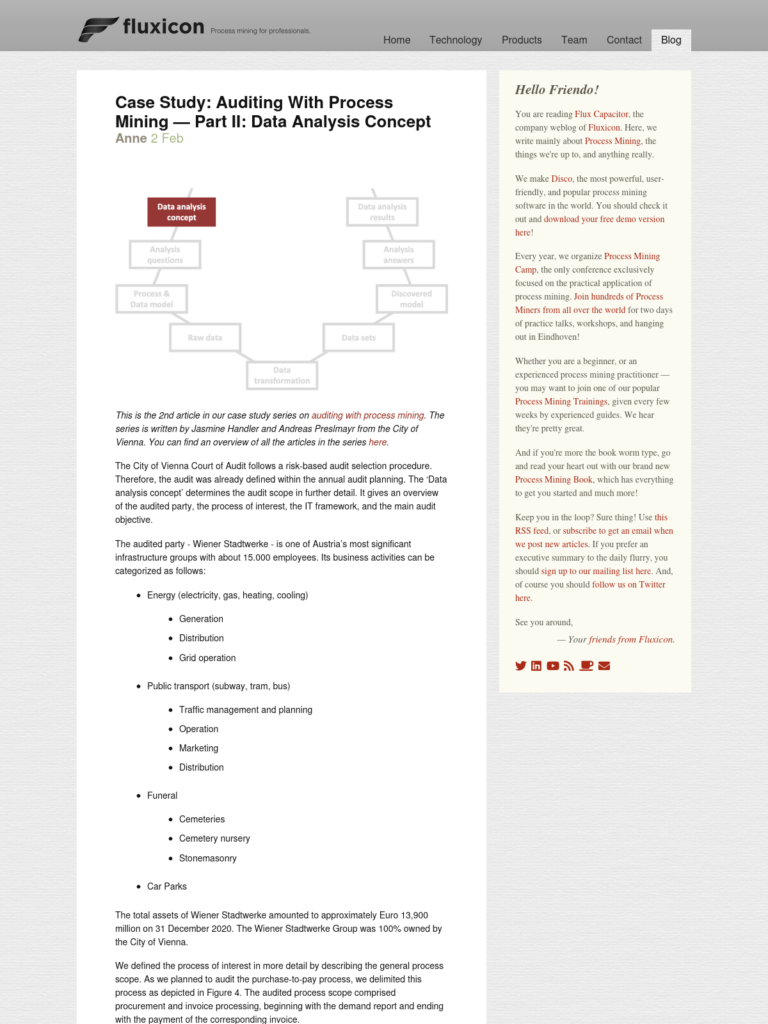Case Study: Auditing With Process Mining — Part II: Data Analysis Concept
This is the 2nd article in our case study series on auditing with process mining. The series is written by Jasmine Handler and Andreas Preslmayr from the City of Vienna. You can find an overview of all the articles in the series here.
The City of Vienna Court of Audit follows a risk-based audit selection procedure. Therefore, the audit was already defined within the annual audit planning. The ‘Data analysis concept’ determines the audit scope in further detail. It gives an overview of the audited party, the process of interest, the IT framework, and the main audit objective.
The audited party – Wiener Stadtwerke – is one of Austria’s most significant infrastructure groups with about 15.000 employees. Its business activities can be categorized as follows:
- Energy (electricity, gas, heating, cooling)
- Generation
- Distribution
- Grid operation
- Public transport (subway, tram, bus)
- Traffic management and planning
- Operation
- Marketing
- Distribution
- Funeral
- Cemeteries
- Cemetery nursery
- Stonemasonry
- Car Parks
The total assets of Wiener Stadtwerke amounted to approximately Euro 13,900 million on 31 December 2020. The Wiener Stadtwerke Group was 100% owned by the City of Vienna.
We defined the process of interest in more detail by describing the general process scope. As we planned to audit the purchase-to-pay process, we delimited this process as depicted in Figure 4. The audited process scope comprised procurement and invoice processing, beginning with the demand report and ending with the payment of the corresponding invoice.

Figure 4: Purchase-to-pay process
This general process scope was used later as a reference point for further investigations and gave a first impression of the start and the end points of the process of interest.
The timeframe for the audit was determined to be the year 2019. More precisely, we considered all orders that were sent between 01 January 2019 and 31 December 2019.
We investigated the IT infrastructure of the City of Vienna Court of Audit and the audited party to get an idea about which type of data and which tools would be available to process and analyze this data.
From our preliminary research, we knew that the audited party used SAP to administrate the purchase-to-pay process. We expected that we would need to transform the data after we exported it from SAP. As an ETL tool to do these transformations, we chose the KNIME Analytics Platform because we already used this software for data transformations in earlier process mining projects and achieved good results.
The primary audit objective was to perform a compliance audit. We wanted to analyze the Wiener Stadtwerke’s purchase-to-pay process concerning its regularity and compliance with organization-specific framework conditions.
Due to this main audit objective, we planned to address aspects like the completeness of the process, segregation of duties, adherence to the four-eyes-principle, and the effectiveness of the internal control system. In addition, we wanted to consider the lead time and the occurrence of bottlenecks from a performance perspective. User experience questions were outside the scope of this audit.
After defining the general framework and the primary audit objective, it was time to specify the focus areas of the audit in more detail. So, in the next step, we identified the concrete analysis questions we wanted to answer within our process mining analysis.
New parts in this auditing series will appear on this blog every week. Simply come back or sign up to be notified about new blog entries here.
Leave a Comment
You must be logged in to post a comment.









